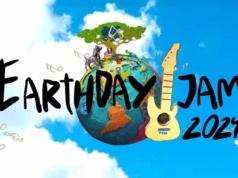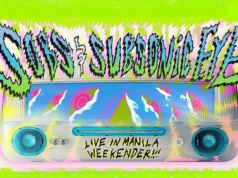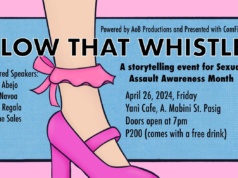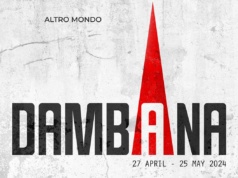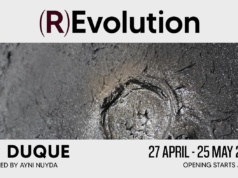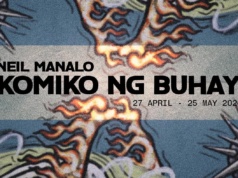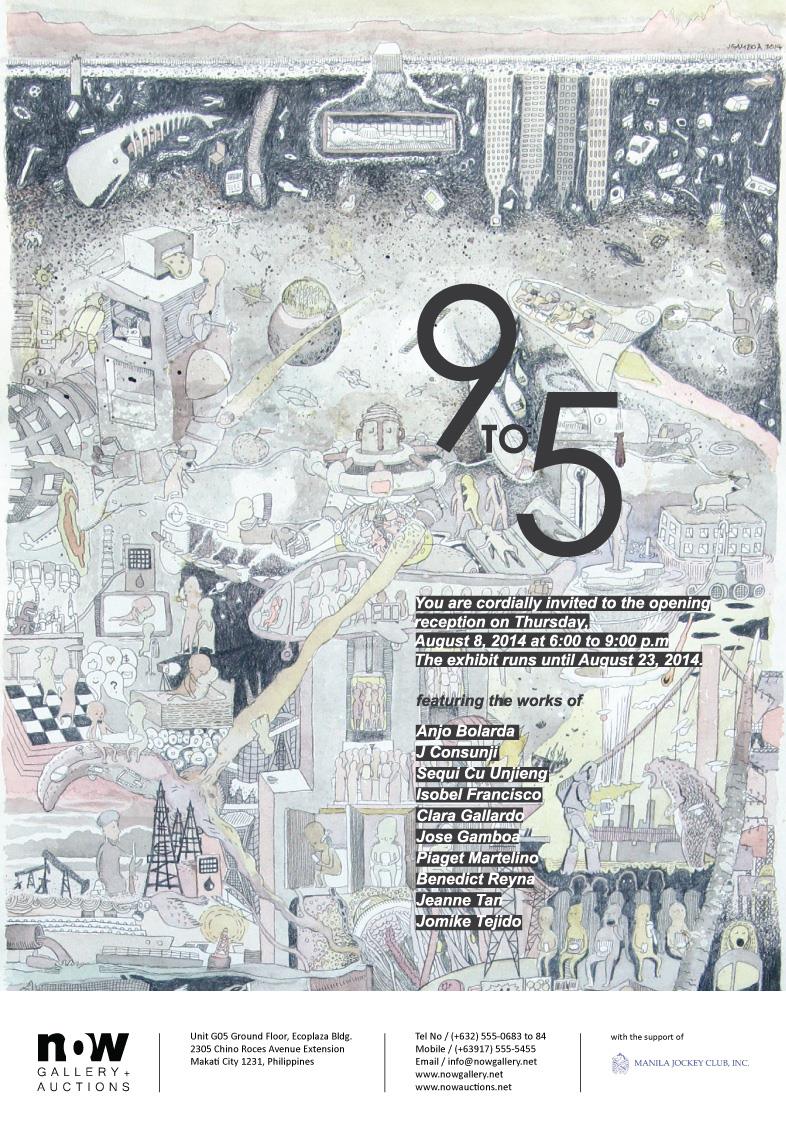
August 8 – 23, 2014
Aug 8 at 6:00pm to Aug 23 at 10:00pm
Now Gallery
Unit G05 Ground Floor, Ecoplaza Bldg., 2305 Chino Roces Avenue Extension, Makati City 1231, Philippines
Opens August 8, 2014 at 6PM
Now Gallery and Auctions
9to5 is a group art exhibition featuring the works of Anjo Bolarda, J Consunji, Sequi Cu Unjieng, Isobel Francisco, Lala Gallardo-Samson, Jose Gamboa, Piaget Martelino, Benedict Reyna, Jeanne Tan, and Jomike Tejido.
(+632) 555-0683 to 84
(+63917) 555-5455
info@nowgallery.net
——— —–
WORKING DISTINCTIONS
by Jose Santos P. Ardivilla
This group exhibition, aptly and cheekily called “9 to 5”, offers distinctions on the notion on labor. Some artists in this exhibit remark that “art is work,” which it is, considering it demands rigorous focus, practice, beating deadlines, and subject to compromises to eventually earn the wages worthy of the product and the producer. Another group of artists here examine the consequences of focusing on just industry and consumption with disregard to the implications both to the fragile environment and the tricky land mine that is human behavior. In another perspective, a cluster of artists have produced visions on how people negotiate with space, time and its proximities and restrictions such as the cubicle and the measured acts and obligations to produce what the client or company needs.
The common threads of this group exhibit are not just the varied look on labor itself but the subject of location and its adjacent elaboration which is space. The title itself, “9 to 5”, is not just a citation of the usual allotment of time for office work. The 9 here is the number of artists participating in this exhibition. The participating artists are: Jomike Tejido, Anjo Bolarda, Benedict Reyna, Jose Gamboa, Clara Gallardo, Isobel Francisco, Jeanne Tan, J Consunji, and Sequi Cu-Unjieng. (The tenth artist, Piaget Martelino, shares his live art on the exhibition opening.) Each work is a personal manifesto regarding their notion of labor, practice, and purpose.
The number 5 comes from the notion of space as an attempt of confinement. In discussing the concept for this exhibit, the artists noted that location of an occupation is often akin to being confined within four walls. Yet, it is within the artist’s capacity to go beyond confinement and course away from the four walls and through the fifth plane where imagination is supreme. This is to cite where artists’ basic tool of vision resides.
“9 to 5” goes beyond a collective of pictures but a procession of professions, and by professions not merely occupation but acts of professing. The works in this exhibit show the intricate and varied points of view about labor be it up in the sky casting a gaze down into a harried landscape of dwindling resources, or letting the imagination soar away from the confines of an occupation entrenched in the cubicle.
These are florid visions on what work can be other than the daily humdrum of machines of industry. Not to say that these are bucolic images set in an office nor shrill celebrations of a job. These are works of tensions shifting between disentanglements and engagement of self, work and space.
From the blue splashes of paint of a female nude in concentration or contemplation to the intricate cut paper of a cubicled landscape to the rigorously detailed phantasmagoria of daydreaming gone amuck, work in this exhibit has several derivatives. Though they are different, they are distinct. The unifying thread here are the dignities and perhaps, the occasional indignities brought about by labor.
What the participating artists are not tired of stressing out is that their work, which is art production, is not a flight of fancy reserved for the elite, but quite a calling with its own adjacent joys and frustrations, triumphs and pain just like any other job.
Labor in our supposed and alleged booming economy has been painted as desirous but for only by those “needed” by industry. Where is labor in these schemata for the artists? Is art needed in this economy? As the works in this group exhibit indicate, “Art is labor that has vision, dignity, gravity, and direction.” Labor cannot be confined to mere production processes and output. It also questions the traditional view of art production as mere stimulation for pleasure and the decorative with the arguments brought forth by these artists. Art is not a mere consumer product but a way through trouble, pleasure articulated further and deeper in the thoughts and expressions that swirl about them. That is hard, sweet work.
—– Jose Ardivilla is a faculty member of the University of the Philippines Diliman’s College of Fine Arts.
RSVP: https://www.facebook.com/events/1449806935288577/

